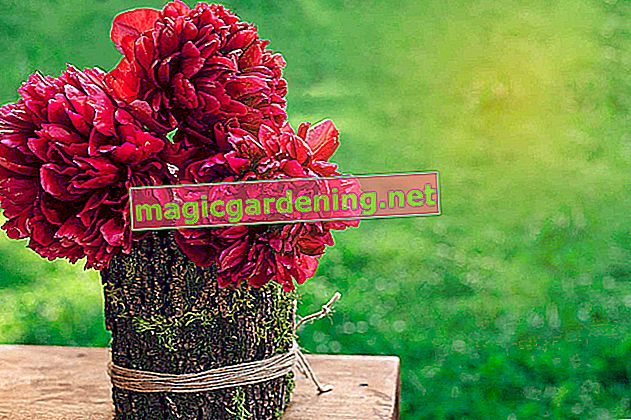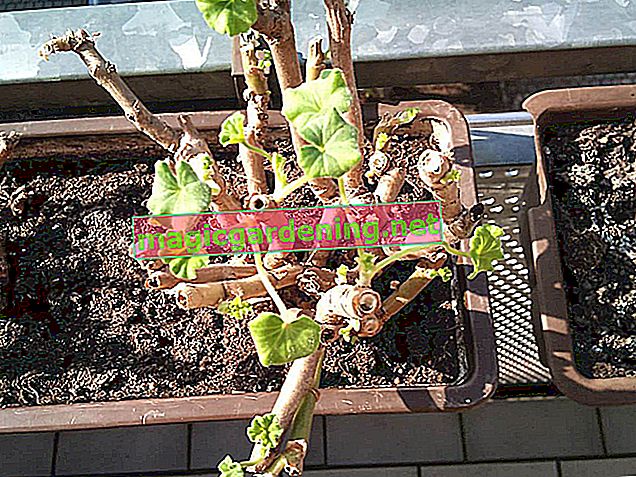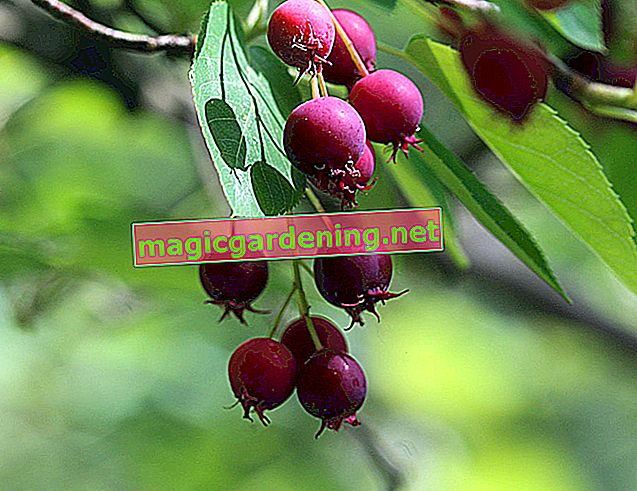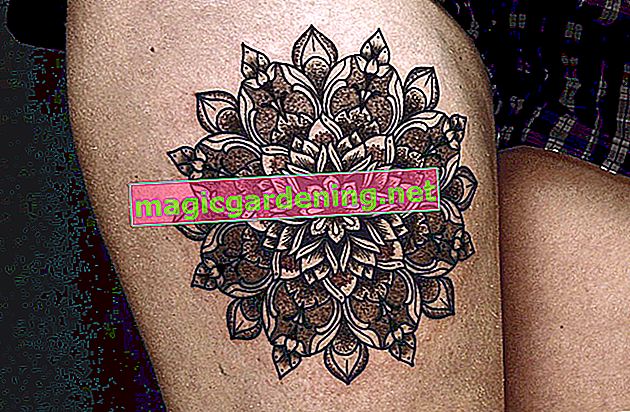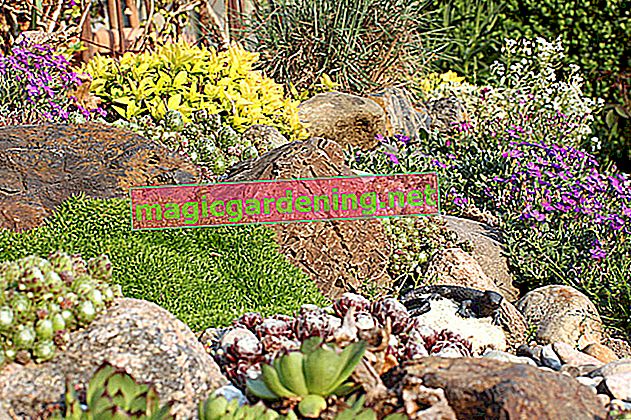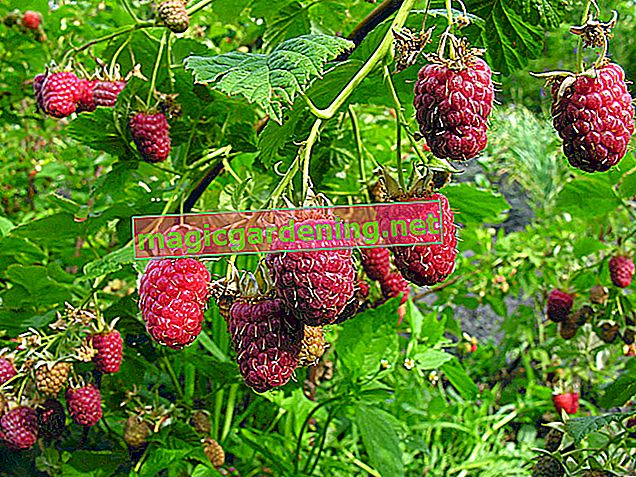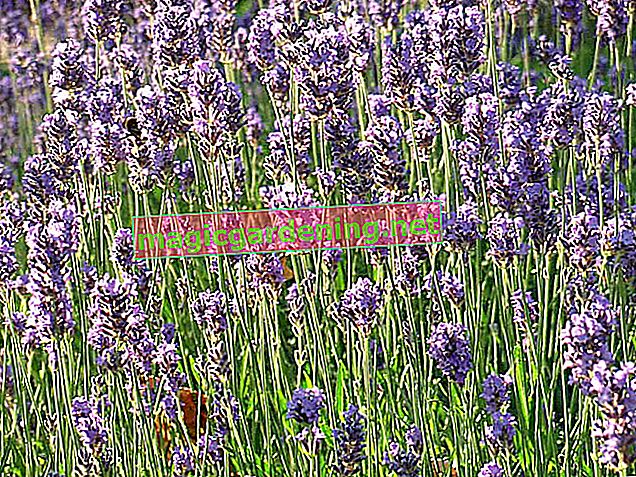
Why should conifers be pruned every now and then? - Types of cuts and dates
Conifers grow extremely slowly - but they do. In contrast to deciduous trees, conifers only grow at the shoot tips . Below their needles, the trees and shrubs have ceased growing forever. In open coniferous and mixed forests, the process takes place in a regulated manner, without pruning or being necessary. Limited garden areas, the cultivation as a hedge or topiary make horticultural intervention necessary to regulate growth from time to time. The following table summarizes all options for pruning conifers:
also read
- Getting the conifers into proper shape
- Skilfully cutting bamboo - tried and tested instructions in the tutorial
- Skillfully cut ball maple - tutorial
| Cut type | Goal / occasion | best date | optional, second appointment | optional third appointment |
|---|---|---|---|---|
| Assembly section solitaire | shapely habit, reliable stability | February to early March | End of June to mid-July | none |
| Conservation cut solitaire | Growth regulation | if necessary in late winter (February to early March) | possibly end of June to mid-July | none |
| Topiary solitaire | Design of geometric or artistic shapes | Late February / early March | End of June to mid-July | Early to mid-August |
| Plant cut hedge | strong branching at the base | after planting | February of the following year | none |
| Section of the hedge | Opaque, light-flooded growth | February to early March (main date) | End of June to mid-July (vigorous varieties) | Mid to late August (strong-growing varieties) |
| Topiary hedge | Preservation of shape, height and width | End of June to mid-July (main date) | Mid to end of August (optional) | none |
Conifers cannot survive a taper cut. The trees do not create dormant buds that sprout as “iron reserves” when twigs, branches or trunks are lost. The only exception is the yew, the pruning of which is devoted to a separate tutorial, including instructions for the rejuvenation pruning.
Note for cutting conifers - rule of thumb prevents cutting errors
For gardeners new to gardening and experienced home gardeners who are cutting a conifer for the first time, there is a simple rule of thumb when making the cut:
- Cut little conifers and only cut them in the needled, green area
As long as you stay in the “green coat” when cutting, you can't go wrong with conifers and coniferous shrubs. An exception applies to completely dead branches that you saw off at the base or on astring. From this point of view, pruning on conifers is less complicated than on deciduous and flowering trees. When pruning shrubs and trees, you need to familiarize yourself with numerous factors, such as flowering time, bud structure and pruning tolerance. When pruning conifers, just keep an eye on the green (sometimes blue or golden yellow) needles, where pruning is possible.
Construction cut on solitaire optimizes shape and stability - cutting instructions
If you are growing a fir, spruce, pine or other tree-like conifer in your garden, you can safely skip this section of the tutorial. These conifer species naturally develop a stable, vitally branched skeleton and do not bald even after many years. Coniferous trees that grow like a shrub , such as arborvitae (thuja), Leyland cypress (Cupressocyparis leylandii), yew (Taxus) or false cypress (Chamaecyparis lawsoniana) benefit from a targeted top cut.
Upright growing, bushy conifer species form several scaffold shoots that are in competition with one another. Each individual drive strives with all its might towards the exposed outside and from there towards the sky. This already results in a one-sided shift in weight in the first few years, which becomes fatal for the plants in the event of snow pressure and storms. A patient and competent structural pruning aims at a stable structure that gives your conifer stability for a lifetime. How to do it right:
- The frequency of the construction pruning depends on the species-specific vigor
- The best time is in late winter, before budding begins
- Cut fast growing conifers again in late June and mid-August
- Select 3 dominant ground shoots and let them grow uncut
- Subordinate further ground shoots to the scaffold shoots and divert them every few years to deeper, short side shoots
A step-like structure of bottom shoots and side shoots, which gather around the triple structure, optimizes stability and protects your conifer from wind and snow breakage. Please note that slow-growing conifers do not need to be pruned every year . If the annual growth is limited to 2 to 5 centimeters left, as in some pine or juniper species, the scissors are used every 2 to 3 years or less.
background
Deriving cut with a key function in the conifer cut
If conifer gardeners are familiar with the derivation pruning, pruning is a masterful success. The pruning technique comes from the demanding fruit tree pruning and has proven to be beneficial for all deciduous and coniferous trees. If you simply cut off branches that are too long or poorly positioned on conifers, you will leave a gap even if you move within the green needle area. A drain cut prevents the shortcoming. Examine the relevant shoot for a short, green, side shoot below. Cut off the worn out shoot where the young shoot branches off. Place the scissors just behind the fork so as not to damage the young wood.Conservation pruning keeps conifers in perfect shape - pruning instructions
Solitary conifers or shrubs will thrive for many years without the need for pruning. At an advanced age, the shape of pine, juniper, fir and other conifers leaves something to be desired. If bare branches that are too long or that are dying off affect the appearance, take immediate action as long as you can cut in the needled area. The best time is in late winter before the new shoot begins. Alternatively, another time slot is open from the end of June to mid-July.
In the needled area, branches that grow unfavorably can be diverted to a more favorable, short side branch. The figure below illustrates the correct procedure. Before doing this, bend the branch in question to one side to see if there are any gaps. If necessary, move the interface a little bit outwards until a possible bald spot is covered by needled side shoots.

Tips
Occasionally two or three vertical central shoots thrive on young fir trees, all of which would like to conquer the top position. If a double or triple point is not on your mind, thin out the weakest shoots in summer while they are still green.
Topiary for a green work of art - this is how a conifer sculpture succeeds
Conifers are very popular when it comes to shaping them as spheres, cones, pyramids and artistic figures. Basically, the special variant of the education follows the pruning rules for the conifer hedge. Depending on the type of wood chosen, pruning is more frequent to regulate growth and shape. Use slender conifers to create pyramids or spirals, such as thuja 'emerald'. Sphere tree of life varieties such as 'Danica' or 'Tiny Tim' naturally have a spherical habit. Stencils made of wood or wire provide valuable help in achieving a flawless result. The following overview summarizes the central framework conditions for the topiary of conifer sculptures:
- Time frame for the topiary: beginning of March to end of August
- Build conifers gradually in stages of a maximum growth of 5 centimeters
- Design the shape using a template right from the start
- It is better to cut often and little instead of rarely and a lot
- Concentrate the circumference of the cut on the needle area
The premium conifer for topiary as a green work of art is the yew. Taxus is the only conifer that tolerates a cut in the unpinned wood. Thus, small mistakes in the heat of the moment are not punished with brown spots and gaps. However, the yew tree is very poisonous and not suitable for the family garden.

Shaping conifers into garden bonsai - tips for training in pruning
Conifers shaped into bonsai catch envious glances over the garden fence. The masterpiece is achieved through an annual cut along the shoot tips . You give the trees their artistic shape by using wires , as is common practice in small-format indoor bonsai. Start gardening bonsai training as early as possible; the conifer will thrive with short, dense shoots. In this way, even beginners can achieve the popular floor growth, which is particularly popular with pines.
Pruning conifer hedge on planting day - this is how you do it right
When purchasing coniferous trees for hedge planting, please do not only pay attention to the height of the dominant central shoot. Your conifer hedge will give you a lot of pleasure if you start with densely branched young trees . Do not rely on your good judgment when planting. For a straight arrangement of the row of bushes, please stretch cords as a guide. Before you water the new hedge with fresh water, dedicate yourself to the following pruning:
- Rule of thumb: the younger the hedge conifers, the stronger the cut on the day of planting
- Shorten plants up to 30 cm tall by at least a third
- Plants over 30 cm in height by 5 to 10 cm, on the sides and flanks by a third
Please clear away the clippings before pampering your new hedge with a starter fertilizer. Sprinkle 100 to 150 grams of horn shavings (€ 6.39 at Amazon *) on the planting strips for each meter of hedge and water. Finally, spread a thin layer of compost or bark mulch to keep the soil from drying out.
background
Plant pruning acts as an effective diversion of reserve materials
What the deflected shot is supposed to achieve in football is done by the plant pruning in conifers. If the ball does not fly in the desired direction, the player redirects the trajectory to the goal. In woody plants, the growth juices strive with pressure towards the tip buds, where a correspondingly strong budding takes place. Lower-lying buds are not or only minimally involved in the distribution. In this regard, the goals of conifers and gardeners are inconsistent. The sap must be diverted so that hedge bushes branch out vigorously at the base. You can do this by removing the tip buds with a bold plant cut. From now on, buds located deep down benefit from the newly distributed sap pressure and sprout diligently.Construction pruning on a coniferous hedge pays off
Conifers grow an average of 10 to 20 centimeters a year. Thuja Smaragd or Taxus baccata, with an annual increase of 30 centimeters, are already considered growth rockets in the coniferous kingdom. It takes many years of patience before a hedge with a privacy screen has formed. Even a knee-high bed or grave border takes several years to achieve the desired shape and height.
Many home gardeners make the understandable mistake of letting a conifer hedge grow uncut in the first few years. Without a cut, the conifers lose their stability and beauty. If you subject your new coniferous hedge to successive top-up pruning , it will thrive in a dense, bushy and stable manner. How to do it correctly:
- Cut the conifer hedge at least twice a year during the construction years
- With each cut back, leave 5 cm of the previous growth
- The best dates are February and the end of June (optionally a third time in the middle / end of August)
- Tension cords as a marking aid for a conical hedge profile
- Raise the hedge base a third wider than the hedge crown
- Remove all inwardly directed and noticeably weak shoots
The illustration below demonstrates the perfect trapezoid shape of the hedge . When coniferous hedges taper towards the crown, the individual coniferous bushes thrive in a light-flooded area . This has the advantage that the green needle coat extends deep into the interior of the hedge and offers a reliable privacy factor. In addition, less snow remains on a narrow hedge surface, which reduces the risk of snow breakage. Last but not least, hedge scaffolding shoots do not fall apart, as is the case with uncut coniferous hedges.

Coniferous hedge at its best - instructions for topiary
Once your conifer hedge has reached the desired height and shines in a lush needle dress, it is up to the topiary to maintain its splendor. The cutting measure is focused on this year's increase, so that you do not come into conflict with the Federal Nature Conservation Act with the ideal date at the end of June and optionally in mid-August. Hedge trimmings are permitted within the grace period from March 1st to September 30th, provided the scope is limited to this year's increase. How to cut properly:
- Check the hedge for nesting birds beforehand and postpone the appointment if necessary
- Cut dead shoots that are growing inside the hedge with one-hand scissors
- Stretch cords along the hedges as a guide for a conical cut profile
- Swing the hedge trimmer (€ 135.56 at Amazon *) up and down parallel to the cutting surface with your arms straight
- Cut the upper side of the cutter bar from the back in a horizontal position
Cut as far as the last interfaces and stay in the green area . A further increase is no longer an advantage in this phase, but leads to space problems over the years. Even 1 centimeter growth per side and year increases the hedge by a full 20 centimeters after 10 years.
Cut vigorous coniferous hedges as early as February
For the pruning of vigorous arborvitae or false cypresses, gardening practice has proven that a first shape cut in February sends the hedges into spring with a neat appearance. If you are dissatisfied with your conifer hedge at the end of winter, do not hesitate to use the hedge trimmer. Cut the green gem on an overcast, frost-free day. Just in time for the first festive days of the year, such as Easter or communion for children, you can look forward to a representative appearance.
Digression
Cut large coniferous hedges into shape electrically
We recommend an electrically operated hedge trimmer for shaping a majestic coniferous hedge that is more than 10 meters long. Please keep in mind that you cut in the middle of the breeding season and frighten off the birds in your garden with the roar of gasoline-powered engines. So that a long power cable doesn't get in the way, simply put it over your shoulder. If your condition allows, prune smaller hedges manually with two-handed hedge trimmers. Modern cordless shrub shears are powerful and can also cope with larger hedge areas. If necessary, a spare battery should be charged and ready to hand so that you can complete the contour cut without annoying interruptions.frequently asked Questions
My 8 year old sugar loaf spruce (Picea glauca 'Conica') is slowly getting a little too big for me. Can I prune the conifer for the first time now in March?
A light cut is possible at the end of the winter rest. It is important to note that you only cut a little and do not pierce the “green coat”. In the interior of the wood, the needles are brown and have died due to the lack of light. If you cut the sugar loaf spruce too deeply, holes will arise that will be visible for many years. The conifer is unable to close the gaps from the inside with green needles.
Our Nordmann fir stands there with brown shoot tips after a harsh winter with temperatures below -20 degrees Celsius. The inside of the fir is still beautifully green. Can I cut off the brown tips?
The Nordmann fir is naturally very frost hardy. If the conifer is too dry, severe frosts can damage the young needles at the tips. We recommend not to cut at first, but to improve the local framework conditions. Provide the fir tree with sufficient water and fertilizer. With a little luck, the brown branch tips will regenerate on their own and you can save yourself the risk of a cut.
With our new house, we bought an old hedge made from arborvitae that has obviously not been pruned for several years. With a width of 2.50 meters and a height of 3.50 meters, the hedge is far too big for us. Can we cut back the trees of life? If so, when and how does it work?
If you want to make sure that the arborvitae hedge is considering pruning, only the green shoot area may be cut. If you continue to cut into the old, brown wood, a well-established thuja hedge can with a lot of luck still cope with this and sprout again. If the general conditions are not so favorable, a total failure is to be feared. It is up to you to decide which result is more important to you. The safe survival of the tree hedge or the desired height and width with the risk of having to replant the entire hedge. The best time to cut is in February on a frost-free day.
We planted our Atlas cedar (Cedrus atlantica) two years ago. We underestimated the vigor of the conifer, because it is already 1.50 meters high and much too big for its current location. We would like to transplant the cedar. When is the best time? Does the cedar need to be cut?
After two years of standing, you are in the right time frame to transplant a conifer. The best time is in late winter or early spring, when severe frosts are no longer to be feared and the cedar has not yet started budding. It is important for a successful process that you move the largest possible root ball. As a conifer, an atlas cedar should not be cut when changing location. A sufficient supply of water and nutrients helps the transplanted tree to compensate for the lost root volume.
I intend to keep an eagle-winged yew tree in the bucket on the terrace. Can I influence the width of the growth in the future with a cut or does the conifer resent me?
Like all yew trees, the eagle-winged yew can easily tolerate a cut. However, the bizarre growth form could be affected by a topiary. We therefore recommend a regular and skillful clearing cut instead of simply shortening branches that are too long.
The 3 most common mistakes
Deformed conifers or conifers with brown spots suffer from cutting errors. It doesn't have to come to that if the gardener is familiar with widespread errors in conifer pruning. The following table lists the three most common cutting errors with damage and information on prevention:
| Cutting errors | Damage | prevention |
|---|---|---|
| cut too deep | brown spots, large gaps | always cut in the needled area |
| no education and structure | uneven growth, frequent wind and snow breaks, bare hedge base | build up gradually with 5 centimeters per year |
| put on the stick | Total failure | Conifers (except yew) never rejuvenate |
Tips
Cuttings from conifers are usually toxic to humans and animals. Please do not dispose of cut shoots on the compost or in meadows. Thuja, yew and other coniferous species are deadly for grazing cattle and horses. Put the clippings in the garbage can. Composting plants and landfills accept larger quantities free of charge.

